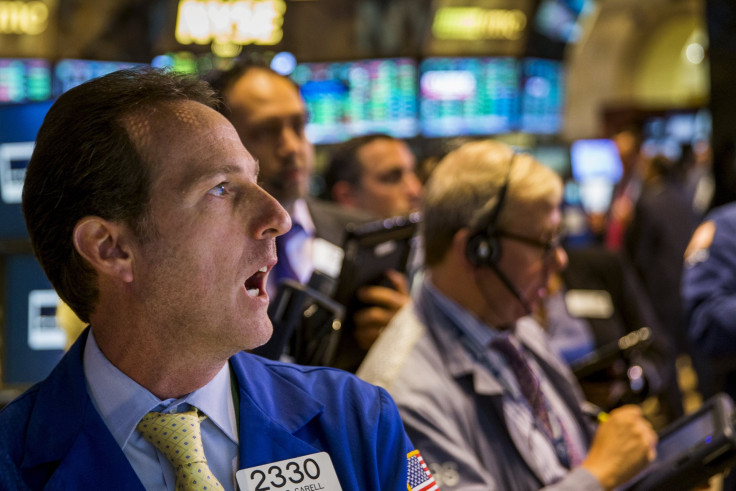Dow Jones Industrial Average Rallies After US Economic Growth Surges In Second Quarter

This story was updated at 4 p.m. EDT
U.S. stocks closed higher for the second straight session Thursday, with the Dow Jones Industrial Average soaring nearly 370 points in another day of volatile trading. The final tally pulled the blue-chip index out of correction territory. All three major indexes jumped more than 2 percent after new reports showed the U.S. economy rebounded in the April-June quarter. The numbers signal that economic growth bounced back after the previous quarter saw labor disputes at West Coast shipping ports that led to a lackluster showing.
“The economy is taking up slack, and that means eventually the nation’s resources will be constrained and inflation will move higher,” said John Canally, chief economic strategist for LPL Financial.
When slack, or the amount of unused capacity in the economy is large, monetary policy is aggressive. But when the slack narrows, central banks ease policy to prevent overheating the economy from higher inflation. “Taking a longer-term view, this report probably pushes the Fed closes towards tightening this year,” Canally said.
The Dow (INDEXDJX:.DJI) gained 369 points, or 2.27 percent, to 16,655. The Standard & Poor's 500 index (INDEXSP:.INX) rose 47 points, or 2.4 percent, to 1,987. And the Nasdaq composite (INDEXNASDAQ:.IXIC) gained 115 points, or 2.5 percent, to 4,813.
U.S. oil prices soared more than 10 percent Thursday, marking their best day since March 2009. West Texas Intermediate (WTI) crude, the benchmark for U.S. oil prices, gained 10.3 percent to $42.56 per barrel for October delivery on the New York Mercantile Exchange. On the London ICE Futures Exchange, Brent crude, the global benchmark for oil prices, added 7 percent to $46.20.
All 10 sectors in the S&P 500 closed higher, led by a 4 percent gain in energy stocks, boosted by higher oil prices. Dow component Chevron Corporation (NYSE:CVX) led the index higher, gaining 5.5 percent. Multinational conglomerate General Electric Company (NYSE:GE), healthcare company UnitedHealth Group Inc. (NYSE:UNH) and athletic retailer Nike Inc. (NYSE:NKE) gained more than 3 percent.
The rally comes a day after China unveiled fresh stimulus measures in a bid to shore up growth in the world’s second-largest economy and U.S. stocks recorded their best day since 2011, snapping six consecutive trading sessions of declines.
"The recent downturn in stock markets does not reflect economic realities on the ground," Stuart Hoffman, chief economist for PNC Financial Group, said in a note. "Consumers are spending, businesses are investing, the housing market is recovering, state and local governments are boosting outlays, and the federal government is no longer a drag on growth."
Global markets traded higher Thursday after China’s benchmark Shanghai Composite closed up 5.4 percent, topping the psychological 3,000 level. The gains helped the index close higher for the first time in five trading sessions.
The rally helped European stocks trade higher, with the pan-European Stoxx 600 closing up more than 3.5 percent. Germany's DAX and France's CAC rose 3.2 and 3.5 percent, respectively.
Better, Stronger, Faster
U.S. stocks continued to rally Thursday on a stronger-than-expected gross domestic product (GDP) report, a day after the Dow surged 4 percent to its third-biggest one-day point gain in history. The gains Thursday helped pull the Nasdaq composite out of correction territory.
U.S. GDP, the broadest measure of goods and services produced across the economy, grew at a seasonally adjusted annual rate of 3.7 percent in the April-June quarter, the Commerce Department said in its second estimate Thursday. The revision is higher than the government’s preliminary estimate last month that showed the economy grew at a seasonally adjusted annual rate of 2.3 percent.
Economists had forecast the U.S. economy grew at a seasonally adjusted annual rate of 3.2 percent in the second quarter, analysts polled by Thomson Reuters said.
The upward revision was because consumption and investment (both private and public) were much stronger than previously expected. “The economy regained a massive amount of momentum in the second quarter and all the evidence from July’s activity and employment data suggests that momentum continued into the third quarter,” Paul Ashworth, chief economist at Capital Economics, said in a research note.
What Now, For The Fed?
The higher revision could create a dilemma for the Fed amid China’s economic slowdown. In June, policy officials were split on whether to raise rates once or twice this year, even when they were forecasting GDP growth would be as low as 1.8 percent to 2 percent. Capital Economics now forecasts growth is now more likely to be somewhere between 2 percent and 2.5 percent.
Economists are looking ahead to the annual Economic Policy Symposium in Jackson Hole, Wyoming, that kicks off Thursday, which brings together many of the world's central bankers. Stanley Fischer, the Federal Reserve’s vice chairman, is scheduled to give a speech that could provide further clues about the Fed's next move following multiple bouts of volatility in the global markets this week.
“Because of the recent global stock market wobble, officials have found another excuse to delay raising interest rates. We don’t think a September rate hike is completely off the table, but we’ll just have to wait and see what officials have to say at this weekend’s Jackson Hole gathering,” Ashworth said.
The Commerce Department maintained its upward growth rate of 0.6 percent for the first quarter, after last month reversing previous estimates that showed the economy shrinking in the January-March period.
The first-quarter number was distorted by the unwinding of a backlog of exports and imports at West Coast ports. The cold winter also played a role in the slowdown, economists say. The West Coast port slowdown had a dramatic impact on shipping: As dockworkers and their employers negotiated a new contract, the disruptions prevented manufacturers from receiving inventories on time, slowing production.
© Copyright IBTimes 2025. All rights reserved.






















